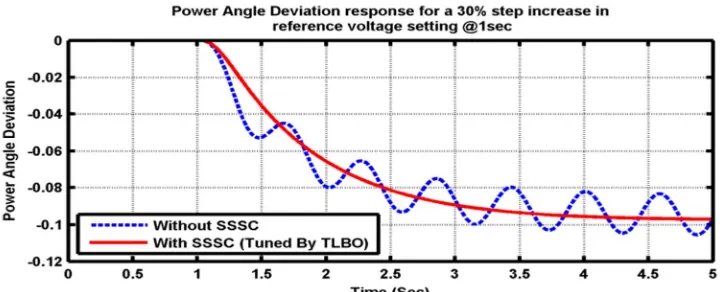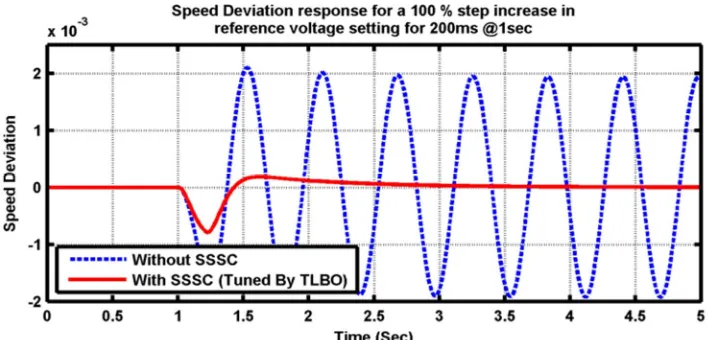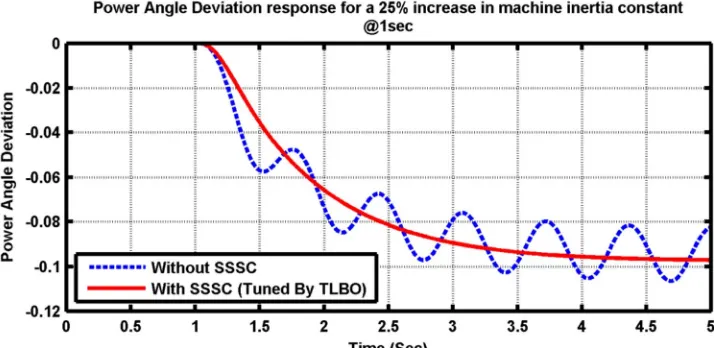©IJRASET: All Rights are Reserved
549
TLBO Tuned SSSC Controller for Improvement of
Power System Stability Performance
Love Kumar Tripathi1, Kapil Parkh2, Raunak Jangid3, Sagar Trivedi4
1
M.tech Scholar, 2Assistant Professor, Electrical Engineering, SITE Nathdwara
3, 4
Assistant Professor, Electrical Engineering SITE, NATHDWARA
Abstract: The operation of power system is quite complicated right from transmission to distribution to the end users. In between the operation of it, many ill conditions arouse interfering with the process. The power system goes through lots of events out, which may cause disturbances to its operation. One such of issues is of low frequency oscillations typically range from 0.1 Hz to 2 Hz. These low frequency oscillation are further be classified as Local and inter-area mode with the frequency ranging from 0.7 to 2 Hz and 0.1 to 0.8 Hz respectively. To damp out these oscillations high gain voltage regulators are employed. But these alone are not sufficient. Hence, for the efficient performance and response controller is designed based on the devices of FACTs (Flexible AC Transmission) family. These devices possess good operation characteristics. In the present context Static Series Synchronous Compensator is being employed. To realize and observe the performance of SSSC based damping controller a Single machine infinite bus system is developed based on Phillips-Haffron model. The given controller is employed in the model in the platform provided by MATLAB/SIMULINK. Then, its analysis was carried out. Further, the performance of the SSSC based controller is improved with the uses of newly developed Teacher Learner Based Optimization (TLBO) technique. The system developed was analyzed with two different cases of change in mechanical torque input and reference voltage setting with different parameters values. The observations have been tabulated for speed deviation, power angle deviation and electrical power deviation respectively in each case with different steps of variations. Finally, the results for these conditions are compared with SMIB system without SSSC and it was verified that it performance in stabilizing the system has bettered with the inclusion of TLBO based SSSC controller.
Keywords: Static Synchronous Compensator; TLBO Algorithm; Phillips Haffron Model of SMIB System; FACTS devices
I. INTRODUCTION
©IJRASET: All Rights are Reserved
550
II. SYSTEMMODELA. Linear Dynamic Model of the Power System with SSSC
Fig.1 Shows the modified Phillips Haffron Model of the SMIB System [3]
K1
S
o D
Ms 1
K4 K5
K6 K2 K8 s do T K ' 3 1
s T K A A '1
K
DCmK
pms K9
1 K7
Kp
DC DC V K
VthKV
DCKq
thKq
DCm + + + + + + + ref V + + fd E -m P e P q E'
Fig.1 Phillips Haffron Model of the SMIB System
B. Overview of SSSC Controller
SSSC is a FACTS device of modern performance quality that uses a voltage source converter connected in series with a transmission line through a transformer. Fig.2 shows SSSC structure and SSSC operates as a series capacitor and the series inductance can be controlled. The main difference is that the input voltage is not related to the intensity of the line and can be managed independently. This function allows the SSSC to work satisfactorily with high loads and with lower loads.[8]
Fig.2 SSSC Structure
1) The Static Synchronous Series Compensator has three basic components: Voltage Source Converter (VSC) – main component.
2) Transformer – couples the SSSC to the transmission line.
©IJRASET: All Rights are Reserved
551
III. THE PROPOSED APPROACHA. Structures of SSSC Based Damping Controllers
[image:3.612.120.495.174.213.2]Fig.3 shows the lead-leg structure of SSSC. The various block of SSSC as gain block, washout block, and a two-stage lead-lag block. A lead-lag operation offers suitable phase leading characteristics for the lag in compensating phase among input and output signals.[8]The input of system is speed and output is system as voltage. The washout block works as high-pass filter and lead-lag block provided as compensation.[13]
Fig. 3 Structure of SSSC based controller
Objective function for single machine infinite bus system is
J = ∫ |∆ω|∙t∙dt (1)
IV. THE TEACHING LEARNING-BASED OPTIMIZATION (TLBO)
All algorithms based on evo1ution and the intelligence of the swarm are probabilistic algorithms and require common control parameters such as popu1ation size, number of generations, size of e1ites, etc. the transition rate. Similarly, PSO uses inertial weight as well as social and cognitive parameters. The proper setting of the algorithm-specific parameters is a very important factor that affects the performance of the algorithms mentioned above. Incorrect1y tuning a1gorithm-specific parameters increases computational effort or resu1ts in an optimal local so1ution. Therefore, Rao et a1. (2011, 2012a, b), Rao and Savsani (2012), Rao and Pate1 (2012) recently launched the TLBO (Teaching-learning Optimization) algorithm, requiring only the common control parameters and non specific control parameter algorithms. Other scalable algorithms require the control of common control parameters and the control of the algorithm-specific parameters. The load of the tuning control parameters is comparatively lower in the TLBO algorithm. Thus, the TLBO algorithm is simple, efficient and requires relatively less computing effort. Therefore, TLBO was used in this work to test the unrestricted and limited multi-object test functions, and the results were compared to other optimization algorithms. TLBO algorithm, a teacher based on the performance impact of learners in the class, is an algorithm that is based on the teaching and learning proposed by Rao [1]. This algorithm, and interacting, describing the two basic modes of learning (i) by teachers (known as a teacher step) and (ii) other learners (known as a learner’s level) Describe. This optimization algorithm is considered the group of learner is considered as the population will be provided different topics for the learners, to different design variables of the optimization problem considered, "goodness of adaptation" learning outcomes optimization problem value .. The best solution for the entire population is a teacher. The design variable is actually a parameter that relates to the objective function of the given optimization problem, and the optimal solution is the best value of the objective function. The work of TLBO is divided into two parts, "teacher level" and "learner level". The TLBO algorithm has already been tested with several limited and unrestricted benchmark functions and is superior to other advanced optimization techniques[2]
A. Algorithm of TLBO
Below is the steps describing TLBO algorithm.
1) The population (no. of students) size is started in the class N, no. of generation G corresponds to no. of units in distribution system D and limits of design variables. (UL upper and LL lower).
Optimization problem: Minimize f(x), such that LL≤ x ≤ UL
f(x)= objective function x= vector for design variables
2) Generate a random population according to the number of students in the class ( N )and number of subjects offered (D). This population is mathematically expressed as
=
, , … … ,
, , … … ,
… … … .
, , … … ,
(2)
©IJRASET: All Rights are Reserved
552
3) Evaluate the average grade of each subject offered in the class. The average grade of the jthsubject at generation g is given by
= ( , , , , … … . , , ) (3) 4) Based on the objective value sort the population from best to worst. The best solution (teacher) is
= ( ) = (4) 5) Changing grade point of every control variables of every individual student. These are,
( )= + ∗( − ) (5)
( )= + ∗( − [1 + ] ) (6)
, are random numbers between [0, 1].
V. RESULT AND DISCUSSIONS
The Sim power system tool boxes are used for analysis and develop the power system model. This is a very useful tool for modeling and simulation. This tool contains power library. Several blocks are available in library such as generators, different types of machines, power electronic converter, excitation system, different drives, transformers, transmission lines etc.
A. MATLAB Model of SMIB System with SSSC Controller
Fig.4 shows MATLAB model of SMIB system with SSSC controller. This paper is carried on a modified Heffron-Phillips model of a single machine infinite bus (SMIB) system integrated with SSSC. In the following a TLBO for SSSC is well-designed to enhance the transient stability of the power system. In order to evaluate the performance of the proposed TLBO in damping low frequency oscillations (LFO), the SMIB power system is subjected to a disturbance such as changes in electromechanical power. Digital simulations are performed in the MATLAB/Simulink environment to provide comprehensive understanding of the issue. Simulation studies validate the effective performance of the developed TLBO in damping electromechanical oscillations in comparison without SSSC.
[image:4.612.45.496.430.681.2]Constants of the model depend on system parameters and the operating condition. Signal m is the modulating index of the inverter, and it is assumed to be the control signal of the SSSC. So that the magnitude of the series injected voltage can be controlled and the desired dynamic compensation of the reactive power will be achieved.
Fig. 4: MATLAB Model of SMIB System with SSSC Controller
©IJRASET: All Rights are Reserved
553
Table 1: TLBO optimized SSSC controller parameters for SMIB
S.N. System
TLBO Optimized SSSC Controller Parameters
K T1 T3
1. SMIB system 19.9239 1e-4 30.4572
[image:5.612.106.501.394.714.2]The characteristic response of the objective utility is shown in Fig.5.
Fig.5 Convergence of fitness role for SMIB power system
B. Simulation Result for SMIB Power System
The performance of the power system was evaluated considering reference voltage setting & mechanical torque input. We tested at various conditions as 30%, 100% step increase. The various graphs the change in speed deviation & power angle deviation has been shown. Response with both no control and TLBO based optimal control are displayed
1) 30% Step Increase in Reference Voltage Setting in SMIB without & with TLBO Tuned SSSC Controller: The fig. 6 to 7 shows both the responses when SSSC is not used and when it is used with TLBO. The various response shows as speed, power angle deviations. From these responses, it is known that uncontrolled response is poorly damped and controlled response settle down quickly as both conditions
Fig.6: Speed deviation in SMIB system in reference voltage setting
[image:5.612.140.495.415.547.2] [image:5.612.136.499.566.712.2]©IJRASET: All Rights are Reserved
554
[image:6.612.128.491.117.295.2]2) 30% Step Increase in Mechanical Torque input in SMIB without & with TLBO Tuned SSSC Controller: The fig.8 to 9 shows both the responses when SSSC is not used and when it is used with TLBO. From these responses, it is known we got better response when we tuned SSSC by TLBO algorithm.
[image:6.612.127.489.314.478.2]Fig.8: Speed deviation in SMIB System in mechanical torque Input
Fig. 9: Power angle deviation in SMIB system in mechanical torque input
[image:6.612.133.489.544.714.2]3) 100% Step Increase in Reference Voltage Setting in SMIB without & with TLBO Tuned SSSC Controller: Fig.10 to 11 shows speed deviation and power angle deviation at reference voltage setting in without and with SSS controller, but when parameter tuned with TLBO we get superior response.
©IJRASET: All Rights are Reserved
555
Fig. 11: Power angle deviation in SMIB system in reference voltage setting
[image:7.612.127.489.328.498.2]4) 100% Step Increase in Mechanical Torque input in SMIB without & with TLBO Tuned SSSC Controller: Fig.12 to 13 shows speed deviation and power angle deviation at mechanical torque input without and with SSS controller, but when SSSC parameter tuned with TLBO system fast settle and improve stability.
[image:7.612.126.486.524.716.2]Fig. 12: Speed deviation in SMIB system in mechanical torque input
©IJRASET: All Rights are Reserved
556
[image:8.612.129.489.115.295.2]5) Parameter Variations at 30% Step increase Mechanical Torque input: Fig.14 to 15 shows speed deviation and power angle deviation at mechanical torque input without and with SSS controller, at 25% increase and 25% decrease machine inertia constant. The system stability improve when we use TLBO tuned SSSC controller.
[image:8.612.130.486.318.498.2]Fig. 14: Speed deviation in SMIB system in mechanical torque input
Fig. 15: Power angle deviation in SMIB system in mechanical torque input
6) Parameter Variations at 30% Step increase Reference Voltage Setting: Fig.16 to 17 shows speed deviation and power angle deviation at reference voltage setting without and with SSS controller, at 25% increase and 25% decrease machine inertia constant. The system stability improve when we use TLBO tuned SSSC controller.
[image:8.612.116.493.569.716.2]©IJRASET: All Rights are Reserved
557
Fig. 17: Power angle deviation in SMIB system in reference voltage setting
VI. CONCLUSIONS
In this paper, A Phillips-Haffron model based SMIB system has been developed with the integration of TLBO based SSSC controller and then was analyzed in MATLAB/Simulink. The conditions under which the system is analyzed are different reference voltage settings and mechanical torque input observing the settling time after deviations in speed, power angle. Under any conditions, the system without SSSC as controller for damping underperforms as the damping is really poor. With the inclusion of TLBO based SSSC controller for damping system performances improves.
REFERENCES
[1] Rao, R. V., & More, K. C. (2015). Optimal design of the heat pipe using TLBO (teaching–learning-based optimization) algorithm. Energy, 80, 535-544.
[2] Rao, R. V., & Patel, V. (2013). An improved teaching-learning-based optimization algorithm for solving unconstrained optimization problems. Scientia Iranica,
20(3), 710-720.
[3] B.T. Ramakrishna Rao, V. Naveen Kumar, P. Chandra Mouli, M. Hari Prasad and T. Chandra Sekhar, “Power System Analysis using SVC and SSSC with
POD Controller”, International Journal of Engineering Science and Computing, pp.4011,-4022, April 2016.
[4] Pathan, “Study of SSSC In Improvement Of Power System Stability With SMIB”, International Research Journal of Engineering and Technology (IRJET),
pp.104-110, Volume: 03 Issue: 03, Mar-2016.
[5] D. K. Sambariya and G. Arvind, “Reduced Order Model of Single Machine Infinite Bus Power System Using Stability Equation Method and Self-adaptive Bat
Algorithm”, Universal Journal of Control and Automation 4(1): 1-7,pp 1-8, 2016.
[6] Rizan A. Ali, Ergun and Ercelebi, “Improve Power Stability & Damping Oscillation in Multi Machine System Using (SSSC) with POD Controller”, Int'l
Journal of Computing, Communications & Instrumentation Engg. (IJCCIE), Vol. 3, Issue 2, pp. 309-315, 2016.
[7] Saurabh S. Shingare, “ Modelling and Analysis of Single Machine Infinite Bus System with and without UPFC for Different Locations of Unsymmetrical
Fault”, International Journal of Engineering Research and General Science, Volume 3, Issue 1, pp.418-426, January-February, 2015.
[8] C. Udhaya Shankar, Dr. Rani Thottungal and S. Mythili, “Stability Improvement and Power Oscillation Damping Using Static Synchronous Series
Compensator (SSSC)”, International Journal of Advanced Research in Science, Engineering and Technology, vol. 2, issue -1, pp. 341-349, January 2015.
[9] Shankar, Thottungal and Mythili, “Voltage stability improvement and power oscillation damping.
[10] Using static synchronous series Compensator (SSSC)”, IEEE Sponsored 9th International Conference on Intelligent Systems and Control (ISCO), pp. 1-6,
2015.
[11] Sidhartha Panda and Narayana Prasad Padhy, “MATLAB/SIMULINK Based Model of Single-Machine Infinite-Bus with TCSC for Stability Studies and
Tuning Employing GA”, World Academy of Science, Engineering and Technology International Journal of Electrical, Computer, Energetic, Electronic and Communication Engineering, Vol:1, No:3,pp. 552-561, 2007.
[12] Sidhartha Panda, N. P. Padhy and R.N.Patel, “Application of Genetic Algorithm for facts based Controller Design”, World Academy of Science, Engineering
and Technology International Journal of Electrical, Electronics, Communication, Energy Science and Engineering, Vol:1 No:2, pp. 256-263, 2007.
[13] Sidhartha Panda and N. P. Padhy, “A PSO-based SSSC Controller for Improvement Of Transient Stability Performance”, World Academy of Science,
Engineering and Technology International Journal of Electrical, Electronics, Communication, Energy Science and Engineering, Vol:1 No:9, pp. 134-1347, 2007.
[14] Issarachai Ngamroo, Jarurote Tippayachai and Sanchai Dechanupaprittha, “Robust decentralised frequency stabilizers design of static Synchronous series






